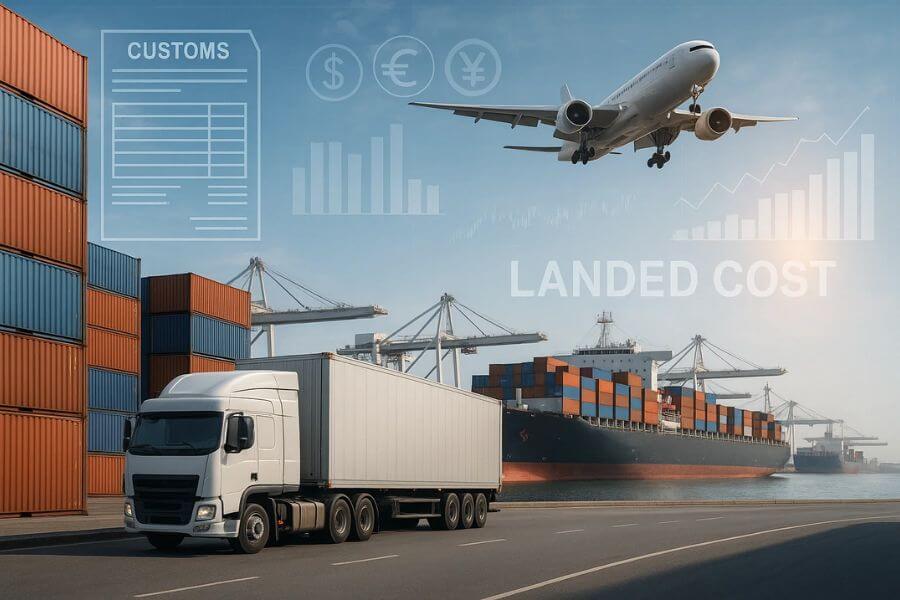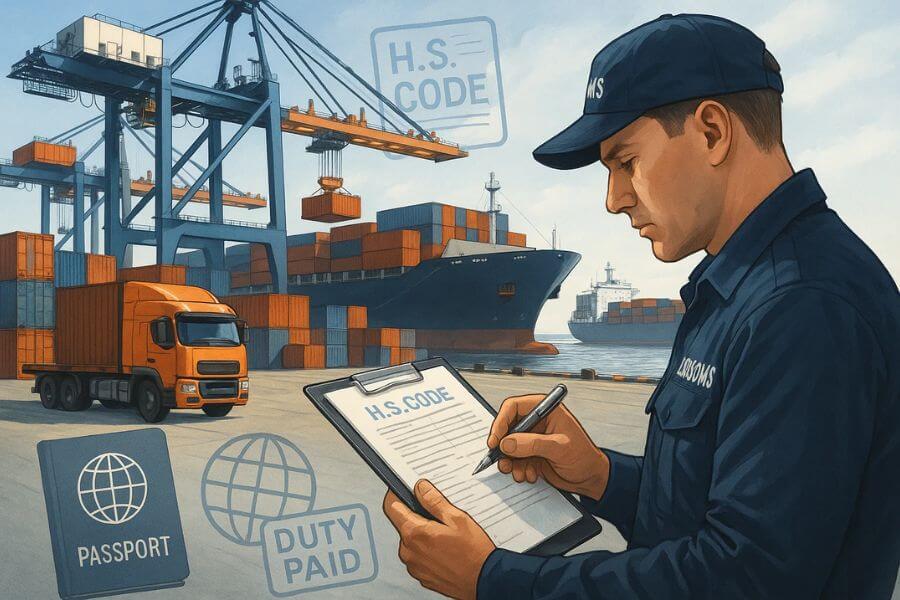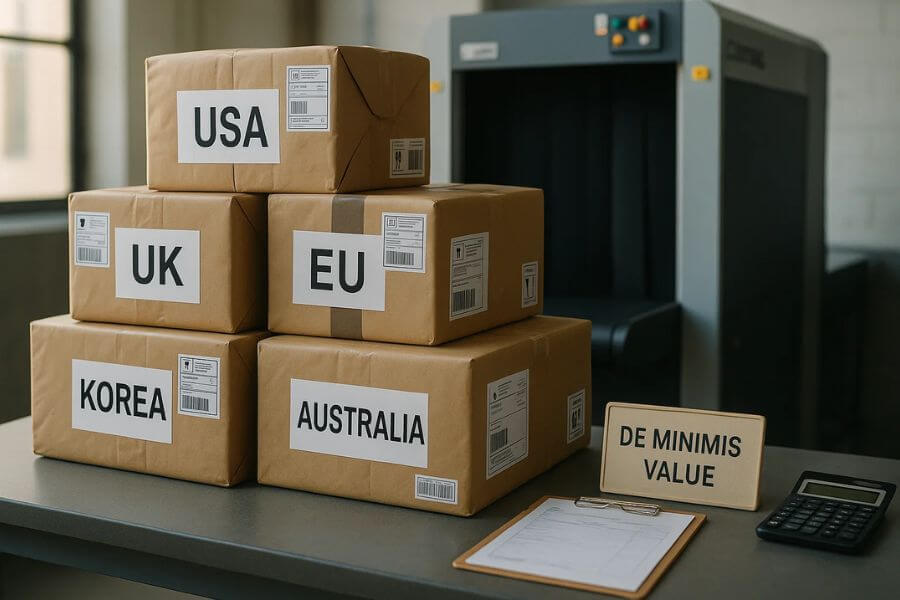In today’s global supply chain, businesses constantly import and export goods across borders. But understanding the true cost of moving products is more complex than just calculating the purchase price. That’s where landed cost comes in.
Whether you’re running an ecommerce brand, a wholesale distribution business, or a manufacturing company, knowing your landed cost is essential for profitability, accurate pricing, and smarter decision-making in logistics.
This guide will cover everything you need to know about landed cost in logistics: what it is, why it matters, how to calculate it, and how to optimize it for long-term growth.
What is landed cost?
Landed cost is the total expense of a product after it has “landed” at its final destination. Unlike the supplier’s invoice price, which only reflects the cost of purchasing the product, landed cost includes every additional charge incurred along the journey.
This means landed cost goes beyond the obvious (like shipping fees) and incorporates hidden charges such as customs duties, tariffs, insurance, handling fees, compliance costs, and even currency conversion rates.
Think of landed cost as the “all-in” price of a product. For example:
- Product purchase price: $10
- International freight: $5
- Customs duties: $2
- Insurance: $1
Total landed cost = $18
By breaking it down this way, you can see why landed cost is the only accurate figure to use when setting selling prices or analyzing profitability.
Without tracking landed cost, businesses risk underpricing products, eroding margins, or even selling at a loss.
What does landed cost matter in logistics?
Businesses that ignore landed cost often discover that what looked profitable on paper quickly becomes unsustainable in reality. Here’s why it’s so important:
Accurate pricing strategy
If you only base your pricing on supplier invoices, you’re not factoring in the true cost of logistics. Landed cost ensures your price point covers all expenses and still leaves room for healthy margins.
For ecommerce sellers on platforms like Amazon or Shopify, where competition is intense, accurate landed cost helps set realistic prices without sacrificing profitability.
Improved profit margins
Landed cost analysis often reveals opportunities for savings. For instance, switching from air freight to ocean freight, renegotiating with carriers, or leveraging free trade agreements can all lower costs.
Even a small reduction, say $0.50 per unit, can translate into significant annual savings when scaled across thousands of products.
Better supplier comparisons
Two suppliers may offer similar unit prices, but one might ship from a country with higher import duties or longer transit times. Landed cost allows for a true apples-to-apples comparison, ensuring you select the most cost-effective option.
Smarter inventory management
By knowing your exact landed cost, you can better forecast expenses, manage cash flow, and plan optimal reorder points. This reduces the risk of both overstocking and stockouts.
Compliance and risk management
Global trade laws are complex. Landed cost calculations that account for tariffs, duties, and regulations ensure compliance and help avoid costly fines or shipment delays at customs.
What are the key components of landed cost?
Landed cost is not a single number pulled from a supplier invoice. It’s the sum of multiple elements, each contributing to the total. Let’s explore them in detail.
Product cost
This is the base price paid to the supplier, typically shown on the invoice. While it’s the foundation of landed cost, it rarely represents the majority of the final expense once shipping and duties are factored in.
Shipping and freight charges
Transporting goods internationally involves multiple steps: trucking to the port, ocean or air freight, and sometimes additional domestic trucking. Freight charges vary by:
- Mode of transport (air vs. sea vs. rail)
- Shipment size and weight
- Distance and fuel surcharges
Freight is one of the most variable components of landed cost.
Customs duties and taxes
Every country has its own tariff structure. Some goods qualify for lower duties under free trade agreements, while others face steep import tariffs. Taxes like VAT or GST also apply in many regions. Miscalculating these can mean serious losses.
Insurance
While optional, cargo insurance is highly recommended, particularly for high-value shipments. Insurance protects against theft, loss, or damage during transit. Without it, you risk absorbing large, unexpected costs.
Handling fees
From port handling and unloading to warehousing, repackaging, and labeling, handling fees cover the operational side of logistics. These often fly under the radar but can significantly impact landed cost, especially for smaller shipments.
Currency conversion and banking fees
If you’re paying suppliers in foreign currencies, exchange rate fluctuations and transaction fees can increase your landed cost unpredictably.
Miscellaneous charges
Other expenses may include inspection fees, compliance certifications, security surcharges, and documentation costs. These are often overlooked but can add up quickly.
How do businesses calculate landed cost?
The general formula for landed cost looks like this:
Landed Cost = Product Cost + Shipping + Duties + Taxes + Insurance + Handling Fees + Miscellaneous Charges
Step-by-step example
Let’s say you’re importing 1,000 smartphone cases from China into the U.S.:
- Product cost: $5,000 ($5 per unit)
- Shipping (ocean freight): $1,500
- Customs duties: $800
- Taxes (import-related): $400
- Insurance: $150
- Handling & warehousing fees: $250
Total Landed Cost = $8,100
Landed cost per unit = $8.10
Now, if you intend to sell each unit for $12, your gross margin is $3.90 per unit. Without including landed cost in your calculation, you might have mistakenly assumed your margin was much higher.
Tools and software used for landed cost calculation
Manually calculating landed cost works for occasional shipments, but businesses with frequent imports or multiple suppliers need automation.
Common tools and platforms
- ERP systems (NetSuite, SAP, Oracle): Provide integrated landed cost tracking as part of broader financial and inventory management.
- Freight forwarder platforms (Flexport, Freightos, ShipBob): Offer real-time estimates of duties, taxes, and shipping costs.
- Ecommerce integrations (Shopify, Amazon Global Selling): Include built-in customs and duty calculators for sellers.
- Standalone landed cost calculators: Useful for small businesses testing supplier scenarios.
Automating the process reduces errors, improves accuracy, and saves countless hours of manual work.
Top 10 strategies to reduce landed cost?
While some parts of landed cost, like government-imposed tariffs and customs duties, are non-negotiable, there are still many opportunities for businesses to reduce costs and improve margins. By strategically managing sourcing, transportation, and logistics operations, companies can make their landed cost more predictable and efficient.
Here are the most effective strategies:
1. Optimize shipping methods and routes
Transportation is often one of the largest components of landed cost. Choosing the right mode and route can save significant amounts.
- Compare modes of transport: Air freight is fast but costly, while ocean freight is cheaper but slower. For urgent shipments, a hybrid model (air for high-demand SKUs, sea for bulk stock) can balance speed and cost.
- Consolidate shipments: Instead of multiple small shipments, consolidating into fewer larger loads lowers per-unit freight and handling costs.
- Explore intermodal shipping: Combining sea, rail, and trucking can sometimes cut costs versus a single-mode approach.
💡 Example: An apparel company shipping from Vietnam to the U.S. switched from air to a mix of ocean + domestic trucking, saving 25% on overall landed cost without impacting sales.
2. Negotiate better terms with suppliers
Your relationship with suppliers can influence far more than just the base product cost.
- Request favorable Incoterms: For example, switching from CIF (Cost, Insurance, and Freight) to FOB (Free on Board) gives you control over freight and insurance, often lowering costs through your logistics partners.
- Bulk order discounts: Larger volumes often mean suppliers can offer price breaks on both goods and freight.
- Supplier proximity to ports: A supplier located closer to a major port reduces inland transportation fees.
💡 Tip: Don’t only compare supplier unit prices; ask for a full breakdown of shipping terms to understand the real impact on landed cost.
3. Leverage 3PLs and freight forwarders
Third-party logistics (3PL) providers and freight forwarders have established carrier networks, volume discounts, and expertise in customs compliance. Partnering with them can significantly reduce costs.
- Volume discounts: 3PLs handle shipments for multiple clients, which allows them to negotiate lower freight rates with carriers.
- Customs expertise: Avoiding documentation errors prevents fines and delays that can increase landed cost.
- Technology integration: Many modern 3PLs offer dashboards that provide real-time landed cost visibility, helping you make proactive adjustments.
💡 Example: An ecommerce brand using a 3PL reduced its landed cost per order by 12% through optimized carrier selection and consolidated shipments.
4. Take advantage of trade agreements
Free trade agreements (FTAs) and preferential tariff programs can significantly reduce customs duties.
- Research trade eligibility: Products sourced from certain countries may qualify for reduced or zero tariffs under agreements like USMCA, EU trade agreements, or ASEAN free trade areas.
- Use correct HS codes: Misclassification of goods can lead to higher duty payments. Double-check tariff codes to ensure compliance.
- Apply for duty drawback programs: Some governments allow refunds of duties paid on imported goods that are later re-exported.
💡 Tip: Work with a customs broker to identify all applicable trade programs and ensure accurate classification.
5. Improve demand forecasting
Poor forecasting leads to emergency shipments, stockouts, or excess inventory, all of which drive up landed costs.
- Use data-driven forecasting: Analyze sales history, seasonality, and trends to plan shipments better.
- Plan buffer stock: Having safety stock reduces the need for expensive expedited shipping.
- Align production cycles: Coordinate with suppliers to match manufacturing schedules with demand cycles, preventing last-minute shipments.
💡 Example: A consumer electronics brand reduced costly air freight shipments by 30% after implementing AI-driven forecasting tools.
6. Minimize returns and reverse logistics
Returns are often overlooked in landed cost calculations, but in ecommerce they can be significant.
- Improve product descriptions and sizing guides to reduce customer dissatisfaction and unnecessary returns.
- Enhance quality control at origin to avoid defective products reaching customers.
- Localize return centers: Having regional return centers reduces international return shipping costs.
💡 Tip: Calculate not just outbound landed cost, but also reverse logistics expenses to see the full picture of profitability.
7. Manage currency risks
Currency fluctuations can add volatility to landed costs when paying suppliers in foreign currencies.
- Lock in exchange rates through forward contracts or currency hedging.
- Negotiate invoices in your home currency where possible.
- Use multi-currency accounts to manage international payments more efficiently.
💡 Example: A retailer importing from Europe hedged EUR/USD exchange rates, stabilizing landed cost per unit even during periods of currency volatility.
8. Streamline compliance and documentation
Customs delays, fines, or inspection fees add unexpected costs. Proactive compliance reduces risk.
- Work with certified customs brokers who understand country-specific regulations.
- Maintain accurate paperwork (commercial invoices, packing lists, HS codes).
- Stay updated on regulatory changes that might impact tariffs or compliance costs.
💡 Tip: Even a minor documentation error can cause port delays, adding thousands in demurrage charges to your landed cost.
9. Consider nearshoring or reshoring
Instead of always sourcing from the cheapest country, consider suppliers closer to your target market.
- Nearshoring reduces shipping times, duties, and freight costs.
- Reshoring can increase production costs but often lowers total landed cost due to fewer tariffs, faster transport, and fewer disruptions.
💡 Example: A U.S. furniture importer moved production from Asia to Mexico. While the per-unit production cost rose slightly, overall landed cost dropped by 18% due to reduced freight and tariffs.
10. Use technology and analytics
Modern supply chains thrive on visibility and data.
- Landed cost software automates calculations for every shipment.
- Predictive analytics helps model different supplier, mode, or route scenarios.
- Digital freight platforms provide instant quotes, enabling smarter decisions before shipping.
💡 Tip: Invest in supply chain visibility tools that integrate with your ERP or ecommerce platform to monitor costs in real-time.
Frequently asked questions about landed cost
Q1: Is landed cost the same as shipping cost?
A1: No. Shipping cost is just one part of landed cost. Landed cost includes everything required to move goods from the supplier to their final destination, such as duties, taxes, insurance, and handling fees. Shipping alone rarely gives the full picture.
Q2: Can landed cost change after shipment?
A2: Yes. Landed cost is sometimes estimated before goods are shipped, but the final number can change. Unexpected customs inspections, port congestion fees, or exchange rate shifts can increase the total cost after shipment.
Q3: How do I calculate landed cost per unit?
A3: Take the total landed cost of the shipment and divide it by the number of units received. This gives you the per-unit landed cost, which is the most useful figure when setting retail prices and analyzing margins.
Q4: Do ecommerce sellers really need to calculate landed cost?
A4: Absolutely. Ecommerce sellers often operate with thin profit margins. Without factoring in landed cost, sellers risk underpricing their products or misjudging profit margins — both of which can harm long-term growth.
Q5: What’s the easiest way to estimate landed cost?
A5: The most reliable method is to use a landed cost calculator or partner with a freight forwarder who provides upfront estimates. Digital platforms and ERP systems also offer built-in landed cost modules to streamline this process.
Summary
In summary, Landed Cost in logistics is the total expense of a product from its origin to its final destination, including the purchase price, shipping, duties, taxes, insurance, handling, and all other related fees.





